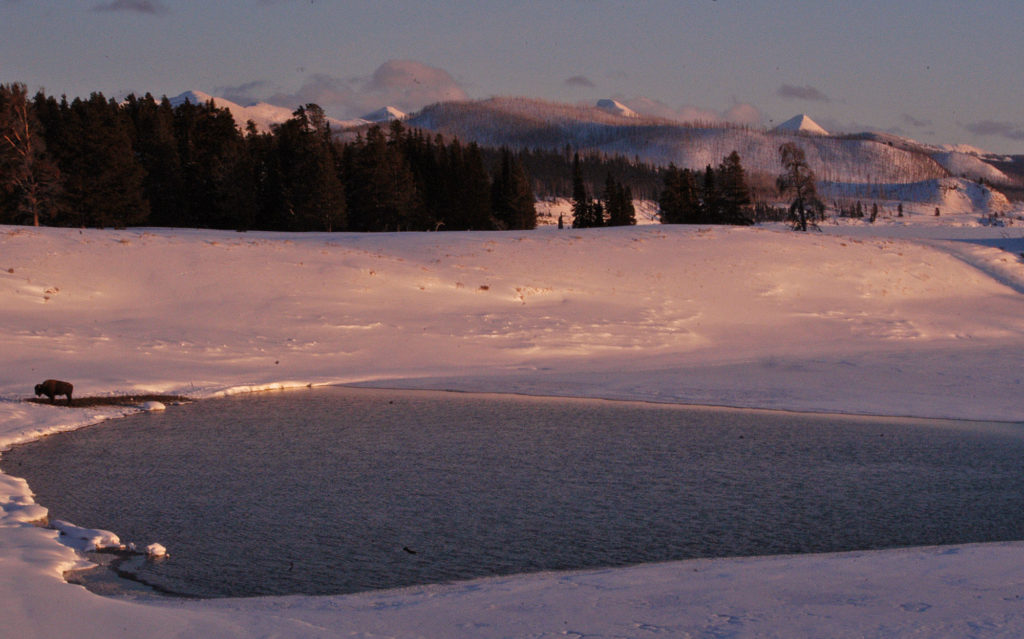
By Ruffin Prevost
CODY, Wyo. — Planners and managers from Yellowstone National Park, including Superintendent Dan Wenk, have been visiting gateway communities this week to host meetings about their ongoing efforts to develop a long-term winter-use plan for the park.
The first meeting was Monday in Cody, where many attendees said they worried that regulations, including one draft proposal to manage over-snow vehicle traffic by “sound events,” would unfairly restrict access to the park.
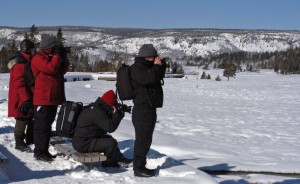
Efforts to nail down a long-term winter-use plan have been complicated for more than a decade by public debate and court challenges over issues like snowmobile traffic and avalanche management on Sylvan Pass, between Cody and Fishing Bridge.
The Park Service is regulating operations this winter in Yellowstone under a “one-year rule,” designating it as a “transition year.” That means use levels and restrictions on snowmobiles and snow coaches, for instance, are the same as under the interim rule that has governed use over the past two seasons: up to 318 commercially guided snowmobiles and up to 78 commercially guided snow coaches are allowed per day.
Meetings this week are designed to take public comments on issues that will be addressed in an upcoming supplemental Environmental Impact Statement evaluating various potential alternatives for winter use. That document will guide a draft winter-use plan to be released later this year. Barring legal challenges, a final version of that plan will be adopted as a long-term regulation by the start of the 2012-13 winter season.
Various preliminary draft alternatives include: eliminating all snowmobile and snow coach travel, plowing park roads from West Yellowstone and Mammoth Hot Springs to Old Faithful, continuing winter operations at the present temporary limits and phasing out snowmobiles to allow only snow coaches.
Park planners said that some elements of preliminary proposed alternatives are included for procedural reasons, and are unlikely to be included in the final plan.
Yellowstone sopkesman Dan Hottle said that attendees at the West Yellowstone planning meeting were concerned primarily about impacts to the local economy, and heavily favored increased guided and unguided snowmobile use. Attendees in Bozeman were mainly from user groups and environmental groups, while the Jackson meeting was smaller and “more subdued” than the Cody meeting, Hottle said.
Judicial battles
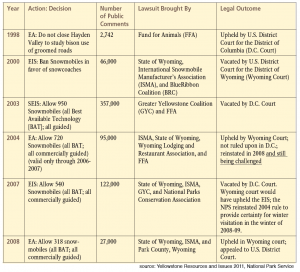
The plan revision is a process that has repeated itself in recent years without yielding an enduring result, as interest groups and government entities have taken their objections to federal court. The numerous judicial battles have made it virtually impossible to craft a long-term plan that can survive litigation.
New ideas for winter-use management in the last decade have been rare, as opponents have dug in their heels on key issues. One new idea discussed in Cody is to use so-called “sound events” to manage and cap the number of snow coaches and snowmobiles in the park at once. The method could potentially allow more visitors while reducing noise, planners said.
Many attendees at the Cody meeting said they either didn’t understand the concept, didn’t like it or didn’t trust the National Park Service to implement it fairly.
Reducing vehicle noise in the park during the winter is an important goal, and one where managers are still working to make sufficient progress, said David Jacob, an environmental protection specialist with the Park Service.
Park visitors and those who have commented on winter use have identified natural soundscapes as an important issue, and the Park Service has a policy that mandates preservation of the peace and tranquility of parks.
Setting a limit on “sound events” — the number of snow coaches or groups of up to 10 snowmobiles — moving through the park at any given time would help manage overall noise and shape how other visitors hear that noise, Jacob said.
“I’m trying to wrap my head around this,” Park County Commissioner Tim French said Monday.
French and others said the sound event management concept seemed unnecessarily complicated.
Former Wyoming House Speaker Colin Simpson said the sound event idea appeared to be “just some other way to define and restrict” public access to the park.
Sylvan Pass
Closing Sylvan Pass was another potential option opposed by many in Cody.
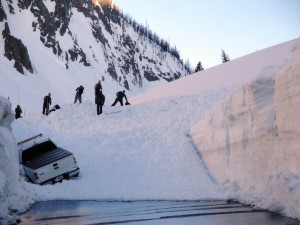
The 1.5 mile stretch of road at an elevation of 8,524 feet lies between the East Gate and Fishing Bridge, and is subject to avalanches throughout the winter, as well as spring and summer slides. A 2007 draft winter-use plan proposed closing the pass, but public outcry from Cody residents and pressure from Wyoming elected officials brought about a working group and discussions with park officials that later resulted in a reversal of that decision.
Various conservation groups have objected to the risk, cost and environmental effects of using a howitzer cannon to mitigate avalanche risks along the pass.
Mark Pearson, conservation program director for the Greater Yellowstone Coalition, said he did not think it was “appropriate to be doing that kind of artillery shelling in Yellowstone National Park for a discretionary recreational activity.”
Park Service cost estimates for avalanche mitigation on the pass have ranged from $200,000 to $325,000 per year.
Wade Vagias, who has worked on Yellowstone winter use planning as an acting management assistant for the Park Service, said the most recent estimate of $325,000 is probably high. Wenk has ordered a more detailed analysis of costs.
Pearson said that GYC sees avalanche control on Sylvan Pass as an unnecessary risk to Park Service staff and visitors. The group also is pushing to phase out snowmobiles in favor of allowing only rubber-tracked snow coaches using best-available technology to reduce noise and emissions.
He said there was little point to a provision in a draft alternative that would allow up to five snowmobile riders per day to enter the park with a noncommercial guide.
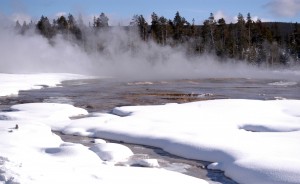
Five sleds is too few to significantly address concerns some have raised about making access to the park more affordable than by commercial guide, Pearson said, and he questioned whether noncommercial guides would have adequate training and expertise.
Park County Commissioner Loren Grosskopf also objected to the five-sled limit, saying it was “like a gunshot to your stomach” for those expecting a larger number of “self-guided” riders to be authorized.
Jacob said the number was small because, if approved, the noncommercial guide option would begin as a “pilot program.”
Bringing back some non-commercially guided sledding would help revitalize winter activity along the North Fork of the Shoshone River, said Dede Fales.
Fales and her husband own Gary Fales Outfitting, the only company holding a Park Service permit for snowmobile tours through the east entrance.
High Country Adventures of Cody had held a concession contract to offer snow coach tours via the east entrance, but the Park Service revoked the company’s permit after it stopped operating a few years ago, Hottle said.
In fall 2010, the Park Service advertised for a new concessioner to offer East Gate snow coach service, but no one has applied, he said.
Dwindling numbers
During the 1990s, visitors could enter the park on snowmobiles without guides, and the North Fork corridor between Cody and the East Gate was busy with downhill and cross-country skiers as well as snowmobile riders. Since then, the ski area was temporarily closed and snowmobile use has plummeted.
In February 1995, the east entrance saw 3,398 snowmobile riders, while West Yellowstone had 50,242 and Mammoth had 2,086.
February 2011 saw just 115 sleds pass through the east entrance, 10,083 at West Yellowstone and 548 at Mammoth.
More snowmobiles from noncommercial guides would help raise numbers at the East Gate, Fales said.
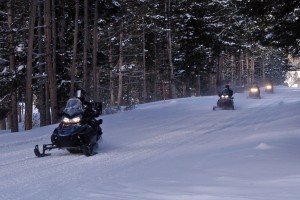
“There are plenty of people in town who used to make that trip. But the fact that they’ve cut out the everyday user means our business may never come back,” she said.
“As a business owner, it feels really uncomfortable when they start saying it costs too much to keep that pass open” based on the number of people using it, she said.
Carol Armstrong, one of the leaders of the grassroots Shut Out of Yellowstone group in Cody said at Monday’s meeting that she worried that closing Sylvan Pass would set back efforts to revitalize the nearby Sleeping Giant ski area, and could harm the area’s winter economy.
“It wouldn’t take us very long to remobilize and raise hell,” said Armstrong, who helped collect thousands of signatures in 2007 demanding that Sylvan Pass be kept open.
“Our North Fork corridor used to be vibrant and alive, and we want that back,” she said.
Wenk urged Armstrong to have faith in the process, but also repeated some advice he gave Cody business owners during an October luncheon meeting.

“I’m concerned about your economy, but I’m not responsible for it,” he said.
Gary Fales said Wenk showed his concern during a private meeting Monday to discuss the Sylvan Pass issue.
Fales said he has done little to market his snowmobile touring business in recent years, because with only a one-year permit issued each winter and lingering uncertainty over the fate of Sylvan Pass, it doesn’t pay to spend heavily on such efforts.
Fales said he understands the budget pressures Wenk is facing, but he hoped a long-term plan would give him a chance to grow snowmobile traffic over Sylvan Pass.
“If this thing was really going, we would chase it,” he said.
Wenk said he had a “good discussion” with Fales as part of his efforts to “understand all the issues related to winter use.”
Fales said he thinks Wenk will be fair and thorough as he works through the planning process.
“I truly felt like he’s working on the project to the best of his abilities,” Fales said.
Contact Ruffin Prevost at 307-213-9818 or [email protected].

There is a large group of U.S. citizens who do not visit Yellowstone in the winter because of the snowmobiles. The noise and air polllution creates an environment that we do not enjoy or want to be a part of.
Unfortunately our voices are not heard.
Are we the silent majority? Maybe.
Yellowstone is a national park, not a local
one. It belongs to all citizens, not just those living in the “gateway” communities.
All Americans should be weighing in on this
issue and should have equal rights.
What are the findings in the EIS for
impacts of snowmobiles on air and noise pollution?
What are the impacts on wildlife?
Could snow coaches meet transportation needs for winter visitors?
Is management of Yellowstone going to be based on sound science or what local groups lobby for? Is the goal of Yellowstone to protect a national treasure, including prevention of noise and air pollution, or
providing jobs?
How many “jobs” really depend on continued snowmobile use? What is the cost to the
resources of Yellowstone?